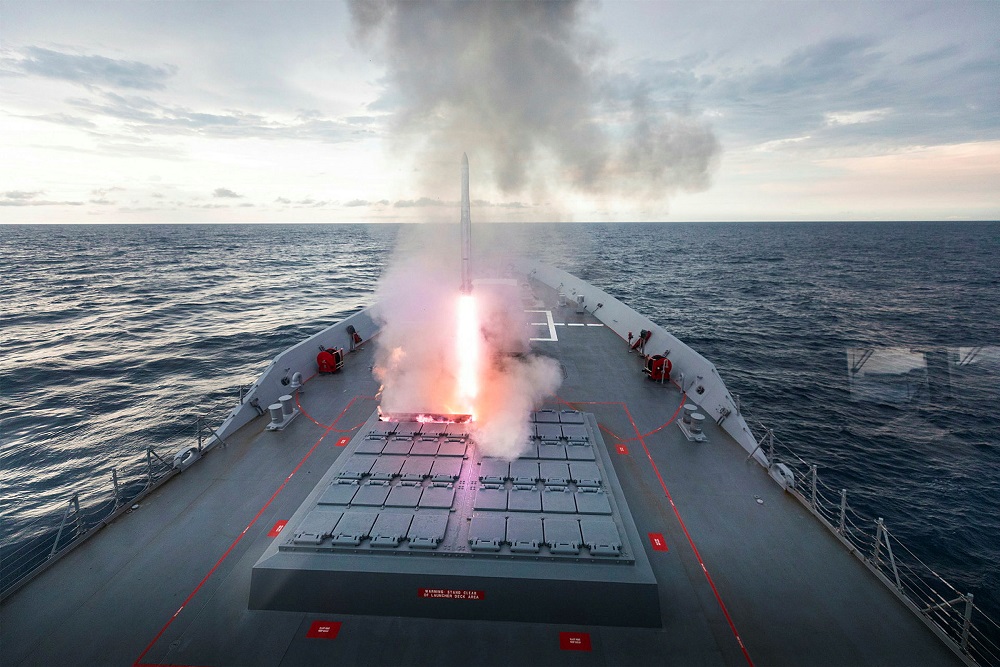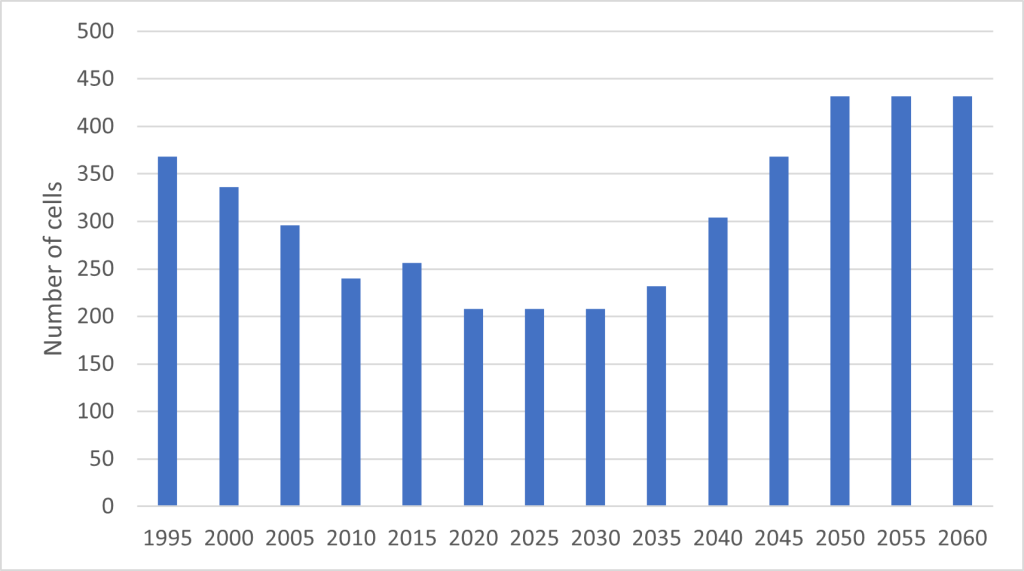Rearming the Royal Australian Navy
Posted By David Shackleton on February 16, 2023 @ 14:30

Much has been written on the importance of guided weapons and ensuring conflicts aren’t lost through a shortage of ammunition. Deputy Prime Minister and Defence Minister Richard Marles’s observation about the need for ‘impactful projection’ [1] implies that the Australian Defence Force’s firepower will be increased, and the intent to manufacture advanced guided weapons in Australia is a welcome development.
In 1995, the Royal Australian Navy possessed 368 missile cells on its major surface combatants. By 2020, that had reduced to 208, a 43% reduction in firepower. It will take until 2045 for the navy to get back up to its 1995 capacity. From 2050 it will plateau at 432, a net increase of 64 cells.
How did this happen, and how many is enough?
Figure 1: Number of missile cells on RAN major surface combatants, 1995 to 2060

After World War II, guided missiles progressively became the primary armament of large warships and countering saturation attacks was a priority. From the late 1970s, the US Navy designed ships around the Aegis combat system [2]. The Arleigh Burke–class [3] guided missile destroyer (DDG) reflects current best practice with 96 cells, and Japan and Korea have adopted the same philosophy. China has a slightly larger ship with 128 cells.
The US Navy uses advanced modelling [4] to assess its needs against a changing [5] threat. That has led to it having more advanced combat systems and heavily armed ships with fast missile launch rates. Large warships in the European region are less well armed than their Pacific counterparts. That might be due to generally shorter transit requirements, timelier logistics support lines, and the proximity of land-based air cover. Conditions in the Pacific are much less accommodating and Australia can’t ignore geographic realities.
The RAN was fully aware of this evolution in naval warfare when the air warfare destroyer [6] program was announced in the 2000 defence white paper, producing the Aegis-equipped Hobart class. Plans for a new, larger frigate to replace the Anzac class [7] were incorporated in the 2009 defence white paper, which warned of increased regional security risks, a mantra repeated in the 2013 and 2016 policy papers. The 2018 decision to acquire a British-designed warship requiring a wholesale change of its combat system, sensors and weapons, and fitting it only with 32 missile cells, appears irrational [8].
Guided weapons continue to increase in lethality, speed, range and accuracy. Their evolution follows the classic cycle of matching, neutralising and further enhancing their features. It’s an endless journey. It’s imperative for naval guided weapons to contribute to joint ‘all arms’ warfare. The US Navy’s soon-to-be-introduced hypersonic guided missile is being developed in concert with the US Army.
Standardisation, where sensible, offers considerable operational and other benefits, not least of which are resupply availability and cost.
Notwithstanding the desire for commonality and for a one-size-fits-all solution, that ambition remains out of reach. From announcements in the public domain, the RAN already operates or will acquire:
- the SM-2 (Standard Missile 2) for long-range air and missile defence
- the SM-6 which has a longer range than the SM-2 and can be used for the same role as well as ballistic missile interception. SM-6 might replace SM-2
- the Evolved Sea Sparrow Missile (ESSM) for shorter-range air and missile defence
- the Tomahawk cruise missile for long-range land and anti-shipping attack
- the NSM (naval strike missile), a medium-range anti-ship missile with a land-attack capability (replacing the Harpoon missile).
Except for the NSM, which is carried in a deck-mounted cannister launcher, these missiles are stored in a strike-length Mk41 vertical launcher system (VLS) module allowing a ship to use different missiles in unpredictable circumstances. The ESSM is small enough for a cell to carry four, but the others occupy a full cell each. It’s suggested that the US Navy’s future large surface combatant, the DDG(X), which is expected to have 128 cells, might also require a larger cell capable of launching hypersonic land-attack missiles now under development.
By 2006, when the RAN’s final Anzac frigate, HMAS Perth, was commissioned, the class had 64 cells, but the ESSMs they contained were to be used for self-defence. In the interim, two of six older Perry-class ships were decommissioned to provide funds to upgrade the remaining four, including adding eight VLS cells. That gave each ship 48 cells, and an improved capability with the longer-range SM-2. After modernisation, the Perry class [9] went from six ships to four, but the total number of cells went from 240 to 192.
HMAS Hobart, the first of the RAN’s three DDGs, entered service in 2015. Its Aegis combat system was matched to a 48-cell VLS, giving a class capacity of 144 cells. Some cells in a Hobart-class DDG can be used for ESSMs (for example, eight cells could carry 32 missiles). But the 40 remaining cells would limit the SM-2s it could carry to the same number, or fewer, if the ship embarked Tomahawks or SM-6s. Operational judgements, which might be compromises, are necessary.
In 1995, the RAN operated three guided missile destroyers, six guided missile frigates and the first of eight smaller frigates, with 368 missile cells in all, the most it has ever possessed. By 2020, the combined effect of several force structure changes meant that across its fleet of eight Anzac-class and three Hobart-class surface combatants, the RAN could provide only 208 cells.
Australia failed to comprehend the fundamental link between firepower and the number of surface combatants—and that it takes decades to overcome deficiencies.
Changing the RAN’s force structure where its major surface combatants (and submarines) are concerned always has very long-term implications for the nation and for the options available to the government.
The eight Anzac frigates are to be progressively replaced from around 2032 by nine Hunter frigates [10], which are expected to have 32 VLS cells accompanied by deck-mounted cannisters for eight surface-to-surface and land-attack missiles. At an estimated 10,000 tonnes, these ships will be about 3,000 tonnes heavier than the Hobart class but have 16 fewer cells. They’ll be slightly larger than the US Navy’s Arleigh Burkes, which have 64 more cells. The Hunters will become the RAN’s most numerous, but least well-armed surface combatants.
If 32 ESSMs are used for self-defence, they would take up eight of the Hunter’s cells. Operational judgements will again have to be made as to which missiles will be loaded into the remaining 24 cells. For instance, two Tomahawks might be needed against some land targets, but how many are to be attacked? And then there’s the question of longer-range air and missile defence, usually requiring two missiles per target for a probable kill.
Even with advanced digital phased-array radars, sophisticated networking and weapon-management capabilities, the RAN’s small number of surface combatants will make the missile shortage more acute when facing a determined opponent.
That the US, Japan and Korea can fit 96 cells into a Hunter-sized ship raises the question of why that’s not being done for the RAN.
The same loss of firepower in the submarine force might become evident if the transition to nuclear-powered boats suffers serious setbacks. The RAN’s primary combat power comes from its surface combatants and its submarines. It’s not a case of choosing one or the other. Australia needs both.
Article printed from The Strategist: https://www.aspistrategist.org.au
URL to article: https://www.aspistrategist.org.au/rearming-the-royal-australian-navy/
URLs in this post:
[1] ‘impactful projection’: https://www.aspistrategist.org.au/impactful-projection-a-porcupine-with-very-long-quills/
[2] Aegis combat system: https://www.lockheedmartin.com/en-us/products/aegis-combat-system.html
[3] Arleigh Burke–class: https://www.naval-technology.com/projects/burke/
[4] modelling: https://www.jhuapl.edu/Content/techdigest/pdf/V02-N04/02-04-Farris.pdf
[5] changing: https://www.jhuapl.edu/Content/techdigest/pdf/V35-N04/35-04-Giare.pdf
[6] air warfare destroyer: https://www.defence.gov.au/project/air-warfare-destroyer
[7] Anzac class: https://www.navy.gov.au/fleet/ships-boats-craft/ffh
[8] appears irrational: https://www.aspistrategist.org.au/australias-hunter-class-frigate-program-must-be-stopped-and-redirected
[9] Perry class: https://www.seaforces.org/usnships/ffg/Oliver-Hazard-Perry-class.htm
[10] Hunter frigates: https://www.navy.gov.au/fleet/ships-boats-craft/future/ffg
Click here to print.